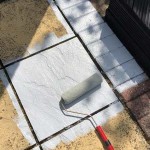Patio Block Sand: The Essential Foundation for Beautiful Outdoor Spaces
Patio blocks are a versatile and durable option for creating inviting outdoor living areas. To ensure their longevity and stability, a crucial component is selecting the right sand for the installation. Patio block sand, specifically designed for this purpose, provides essential support and helps prevent settling or shifting.
Benefits of Using Patio Block Sand:
Patio block sand offers numerous advantages, including:
- Optimal Support: The angular shape of the sand particles creates interlocking voids, providing exceptional stability and support for patio blocks.
- Drainage: Patio block sand is porous, allowing water to drain efficiently. This prevents excess moisture from accumulating and damaging the blocks.
- Leveling: The sand can be easily leveled, ensuring an even base for the patio blocks, preventing slopes or uneven surfaces.
- Compactibility: Patio block sand compacts well, forming a firm and stable foundation that supports heavy foot traffic and outdoor furniture.
Choosing the Right Patio Block Sand:
When selecting patio block sand, consider the following factors:
- Particle Size: Ideal particle sizes range between 0.01 and 0.05 inches. Smaller particles can fill in voids and provide better support.
- Shape: The angular shape of the sand is crucial for interlocking and stability. Avoid rounded or spherical particles.
- Compressibility: Choose sand that can be compacted easily without breaking down or forming a hardpan layer.
- Moisture Content: Patio block sand should be slightly damp, not wet or dry. Damp sand compacts more effectively and maintains its shape.
Installing Patio Block Sand:
For proper installation, follow these steps:
- Prepare the Base: Level and compact the soil or gravel base before spreading the sand.
- Spread the Sand: Apply a layer of patio block sand approximately 2-3 inches thick and level it carefully.
- Compact the Sand: Use a hand tamper or plate compactor to firm up the sand, ensuring it is level and stable.
- Level the Sand: Check the level of the sand using a leveling tool and make necessary adjustments.
Maintaining Patio Block Sand:
To maintain the integrity of your patio block sand, consider:
- Regular Sweeping: Sweep the sand surface regularly to remove dirt and debris that can clog the voids.
- Watering: Water the sand lightly to maintain moisture. Avoid overwatering, as excess moisture can wash away the sand.
- Refilling: As the sand settles, it may be necessary to refill and compact the gaps to maintain the level and support.
By choosing the appropriate patio block sand and following these guidelines, you can ensure a sturdy and enduring foundation for your outdoor living space. Enjoy a beautiful and functional patio for years to come.

Southwest Boulder Stone 40 Lbs Tan Paving Joint Sand Stabilizing For Pavers Brick Concrete Blocks Patio Stones 02 0332 The Home Depot

6 Common Paver Installation Mistakes Western Interlock

Southwest Boulder Stone 40 Lbs Gray Paving Joint Sand Stabilizing For Pavers Brick Concrete Blocks Patio Stones 02 0333 The Home Depot

Polymeric Paver Sand Bagged Joint Mutualmaterials Com

Sealing Pavers With Sand 10 Expert Tips From Top Paver Companies The Sealer

What Kind Of Base Should You Use For Patio Pavers Installation

Pavestone 0 5 Cu Ft Paver Sand 98000 The Home Depot

Applying Polymeric Sand To An Existing Patio Or Walkway Sakrete

What Kind Of Base Should You Use For Patio Pavers Installation

A 6 Step Guide To Laying Paving Stones Yourself Hilgersom Inc








